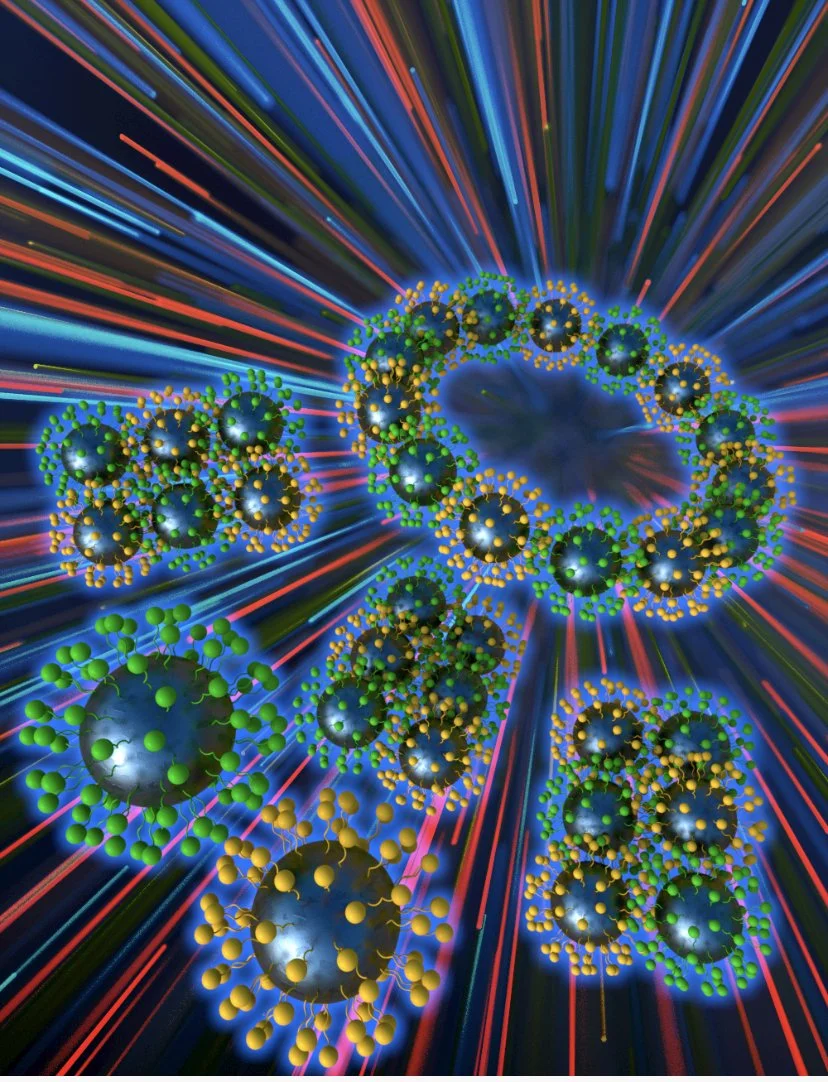
Research Directions
Research Direction #1. Developing Nano-Enabled Tools and Platforms
for Improving Image-Guided Surgical Interventions.
Research Direction #2. Designing Customizable Nanocarriers
for Therapeutic Interventions in Clinically-Relevant Models
Cancer nanomedicines have garnered significant attention for their advantages over conventional therapies, including improved drug solubility, prolonged circulation, and enhanced tumor accumulation via the enhanced permeability and retention (EPR) effect. While nanomedicines such as liposomes and polymeric micelles show promise for , their clinical translation in cancer is hindered by challenges like low delivery efficiency, premature drug leakage, and off-target effects.
In our lab, we employ nanoengineering principles to design structurally defined nanomedicines with improved tumor tropism and controllable therapeutic behavior. Inspired by the current poly-prodrug literature, we are extending this concept to polymer architectures derived from therapeutic acid-based monomers, enabling the formation of nanoparticles with high densities of active units and tunable, sustained bioactivity. These nanostructures also incorporate optical signatures for noninvasive tracking in vivo, supporting real-time assessment of delivery and therapeutic performances.
In parallel, we are developing disease-tropic lipid nanoparticles capable of selective accumulation in clinically relevant disease sites including metastatic tumors and atherosclerosis plaques. Together, these efforts contribute to a modular, programmable nanomedicine pipeline that enhances precision in both cancer therapy and image-guided interventions.
Selected Publications: (i) Rezaei, B., Harun, A. et al. Adv. Health. Mater 2024; (ii) Srivastava, I. et al. ACS Applied Materials & Interfaces 2021; (iii) Srivastava, I. et al. ACS Applied Materials & Interfaces 2020; (iv) Schwartz-Duval, A. S. et al., Nat. Comm 2020; (v) Misra, S. K., Srivastava, I., et al., Journal of American Chemical Society 2017.
Students Leading this Direction: Mahenour Megahed (PhD Student), Asma Harun (PhD Candidate), Kaylee Herrera (URS Scholar), Isabella Vasquez (Barry Goldwater Scholar).
Research Direction #3. Spectroscopic and Optical-Based Platforms For Disease Diagnostics
In recent years, optical and surface-enhanced Raman scattering (SERS)-based spectroscopy techniques have emerged as pivotal tools in disease detection. Enhancing the sensitivity and specificity of these spectral detection methods is crucial for developing accurate diagnostic applications that can be employed at point-of-care. The integration of artificial intelligence (AI) technologies presents a significant opportunity to further improve detection accuracy through advanced machine learning algorithms. By analyzing complex spectral data, AI can identify patterns and biomarkers that may be missed by traditional methods, ultimately leading to more reliable and timely diagnosis interventions. This convergence of both optical and SERS with AI underscores our commitment to advancing diagnostic capabilities and improving patient outcomes.
To achieve this goal, our lab focuses on designing novel bioinspired optical and SERS-based nanosensors, utilizing innovative design principles to facilitate a wide range of analyte detections pertinent to biomedical health and environmental monitoring. Our research encompasses diverse applications, from identifying cancer-cell secreted exosomes in patients with solid tumors to detecting microplastics and nanoplastics in aquatic samples from the Lubbock community. Our primary emphasis in exosome studies is on cancer, particularly hepatocellular and pediatric cancers, due to the availability of patient tumor samples from our clinical collaborators at TTUHSC. We collaborate with data scientists to analyze the substantial datasets generated, identifying trends that enhance our ability to use exosomes for predicting cancer, monitoring treatment responses, and assessing cancer radioresistance. This multidisciplinary approach aims to advance diagnostic capabilities and improve patient care.
Selected Publications: (i) Vasquez, I. et al. WIRE Nanomed. 2025; (ii) Lin, L.,..,Srivastava, I.,…, Ye, J. et al. ACS Applied Materials & Interfaces 2025; (iii) Srivastava, I. et al. ACS Applied Materials & Interfaces 2024; (iv) Srivastava, I. et al. ACS Nano 2022; (v) Alafeef, M., Srivastava, I. et al. ACS Sensors 2020; (vi) Srivastava, I. et al., Small Methods 2020; (vii) Pandit, S. et al., ACS Sensors 2019, (viii) Srivastava, I. et al., Adv. Funct. Materials 2019.
Students Leading this Direction: Md. Hasnat Rashid (PhD Student), Hunter Jones (TrUE Scholar).
The interests listed above are not comprehensive. We support trainees in creating projects that fuel their scientific curiosity while promoting their career development. Incoming members are encouraged to either contribute their ideas to ongoing lab research
or initiate novel research directions.
Fundings.
We are grateful to the following sponsors for their support of our research! Thank you!
Ongoing Collaborations.
Our most active collaborators presently are: Joshua Tropp, Ulrich Bickel, Ognjen Milanjic, Shreya Raghavan, Syed Muhammad Usama, among others!
Surgical resection remains a cornerstone in the treatment of solid tumors. However, distinguishing between malignant and healthy tissue often relies on tactile and visual cues, as well as the surgeon's experience. This reliance can result in positive surgical margins, where residual tumor tissue is inadvertently left behind ultimately leading to negative treatment outcomes and survival rates, and pose significant economic challenges. To tackle this challenge, our lab is developing advanced surgical tumor imaging techniques designed to minimize the frequency of adverse outcomes. One key approach involves the creation of nanoparticles (NPs) that are responsive to near-infrared I/II fluorescence imaging or afterglow imaging. These NPs show promise as optical contrast agents for in vivo image-guided surgical interventions due to their unique optical properties. In parallel, our lab is developing innovative 3D-printed phantoms that simulate tumor cells. These phantoms replicate the tissue composition, optical properties, and contrast agent concentrations found in vivo. By using these phantoms, we and clinicians can rigorously test and refine imaging agents, surgical tools, and treatment strategies in a controlled and reproducible environment.
Selected Publications: (i) Vasquez, I. et al. ACS Nanoscience Au 2025; (ii) Harun, A. et al. ACS Nano 2025; (iii) Bendele, N. et al. Adv. Funct. Mater 2024; (iv) Gill, N. et al. Adv. Health. Mater 2024; (v) Srivastava, I. et al. ACS Nano 2023, (vi) Chen, C. et al., Science Advances 2023.
Students Leading this Direction: Asma Harun (PhD Candidate), Isabella Vasquez (Barry Goldwater Scholar), Itzel De Leon (URS Scholar).





